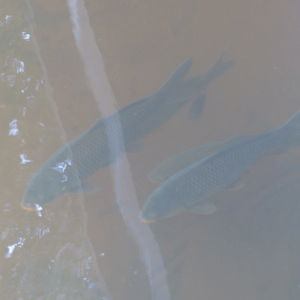Grass carp facts for kids
Quick facts for kids Grass carp |
|
|---|---|
 |
|
| Scientific classification | |
| Synonyms | |
|
The grass carp (Ctenopharyngodon idella) is a large, plant-eating freshwater fish. It belongs to the Cyprinidae family. This fish is originally from eastern Asia. Its natural home stretches from northern Vietnam to the Amur River, which is on the border between Siberia and China. The grass carp is the only species in its group, called Ctenopharyngodon.
People in China raise grass carp for food. It was also brought to Europe and the United States. There, it helps control unwanted water plants. Today, it is the most produced fish in aquaculture (fish farming) worldwide. Over five million tons are produced each year!
Grass carp live in large, cloudy rivers and lakes nearby. They can handle many different temperatures. They are ready to reproduce and lay eggs when the water temperature is between 20 to 30 °C (68 to 86 °F).
Contents
What Does a Grass Carp Look Like?
Grass carp have long, chubby bodies shaped like a torpedo. Their mouth is at the end of their head and points slightly upwards. They have firm lips and no whiskers (barbels). A full line of 40 to 42 scales runs along their side. They have strong, ridged teeth in their throat.
The dorsal fin (on their back) has eight to 10 soft rays. Their anal fin is closer to their tail than in most carp. Their body is dark olive on top, turning brownish-yellow on the sides. Their belly is white, and they have large, slightly outlined scales.
How Big Do Grass Carp Get?
Grass carp grow very fast. Young fish that are about 20 cm (7.9 in) long in spring can grow to over 45 cm (18 in) by fall. They usually grow to be about 60–100 cm (23.5–39.5 in) long. The biggest grass carp can reach 2.0 m (6.6 ft) in length and weigh up to 45 kg (99 lb).
Most grass carp live for 5 to 9 years. Some have been known to live for 11 years. In Silver Lake, Washington, some grass carp have lived for over 15 years. They can eat up to three times their own body weight every day! They do well in small lakes and calm waters with lots of freshwater plants.
Where Do Grass Carp Live and What Do They Eat?
This fish lives in lakes, ponds, and calm areas of large rivers. They prefer big, slow-moving or still water bodies that have lots of plants. In the wild, grass carp lay their eggs in fast-moving rivers. Their eggs are a bit heavier than water. They develop as they float downstream, kept from sinking by the moving water. If the eggs sink to the bottom, they usually die.
Adult grass carp mostly eat aquatic plants. They feed on tall water plants and plants that grow underwater. They might also eat dead plant matter, insects, and other small creatures without backbones.
How Grass Carp Were Introduced to New Places
Grass carp have been brought to many countries around the world. In the Northern Hemisphere, they were introduced to places like Taiwan, Iran, Japan, the United States, and many countries in Europe. In the Southern Hemisphere, they were introduced to Argentina, Australia, New Zealand, and South Africa.
Grass carp have only managed to create new, self-reproducing groups in a few large rivers. This shows they need very specific conditions to lay eggs and have their young survive.
Grass Carp in the United States
In the United States, grass carp were first brought in 1963. They came from Taiwan and Malaysia to fish farms in Alabama and Arkansas. The first time they got into the wild was likely by accident in 1966. This happened when some escaped from a U.S. Fish and Wildlife Service farm in Stuttgart, Arkansas. After that, people started releasing them on purpose in 1969.
Since then, they have been widely introduced, sometimes legally, sometimes by accident, or even illegally. By the 1970s, they were in 40 states. Now, they have been reported in 45 of the 50 states. In 2013, it was found that they were reproducing in the Great Lakes Basin. Many states still use them to control unwanted water plants.
Using Grass Carp to Control Weeds
Grass carp were brought to New Zealand in 1966. Their job was to control the growth of water plants. Unlike other fish brought to New Zealand, experts studied the grass carp carefully before releasing them. Now, the New Zealand government allows them for weed control, but each time needs special permission.
In the Netherlands, grass carp were also introduced in 1973 for the same reason. Their release was carefully managed by the Dutch Ministry of Agriculture. In both these countries, it's easier to control them because they usually don't reproduce naturally. This is due to their very specific breeding needs. In other places, people use sterile (unable to reproduce) grass carp to control weeds. These fish are called triploid fish.
Fishing for Grass Carp
Grass carp can grow very large and are strong fighters when caught on a fishing rod. However, they can be hard to catch. This is because they are plant-eaters and are very cautious. The IGFA (International Game Fish Association) world record for a grass carp caught with a line and hook is 39.75 kg (87.6 lb). This fish was caught in Bulgaria in 2009.
In places where grass carp are used to control weeds, fishers are often asked to put any caught fish back into the water alive and unharmed. This helps keep the fish population healthy for weed control. These fish are also popular in areas where bowfishing (fishing with a bow and arrow) is allowed.
See also
 In Spanish: Carpa herbívora para niños
In Spanish: Carpa herbívora para niños





